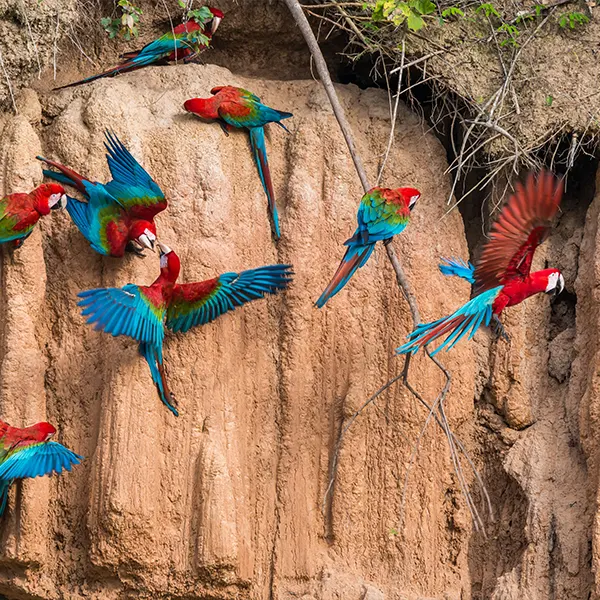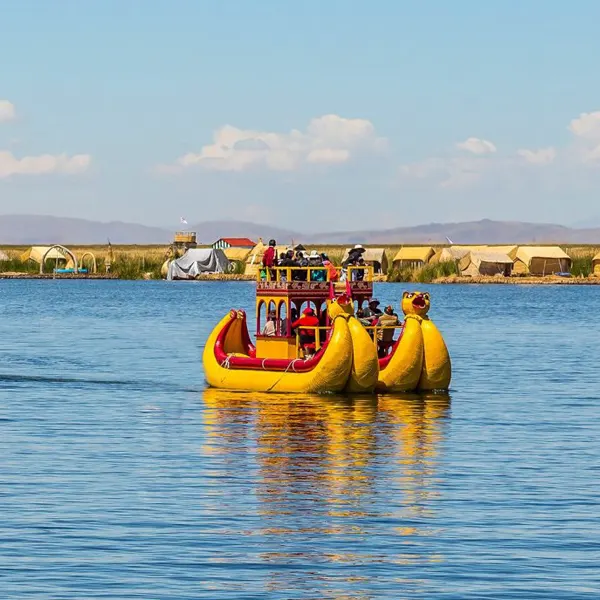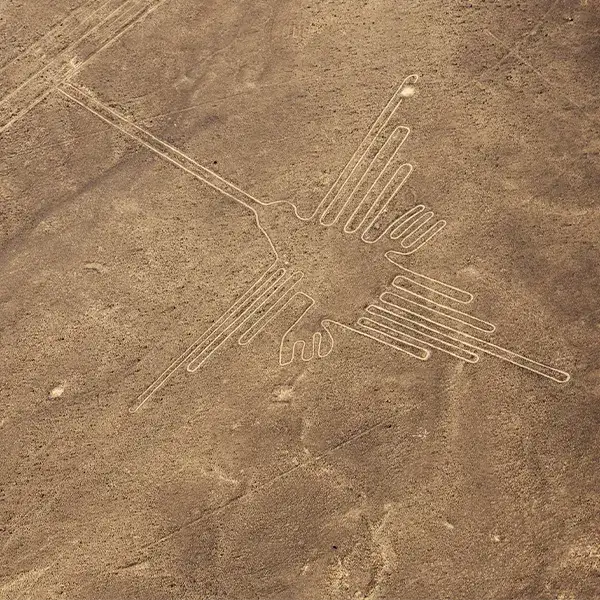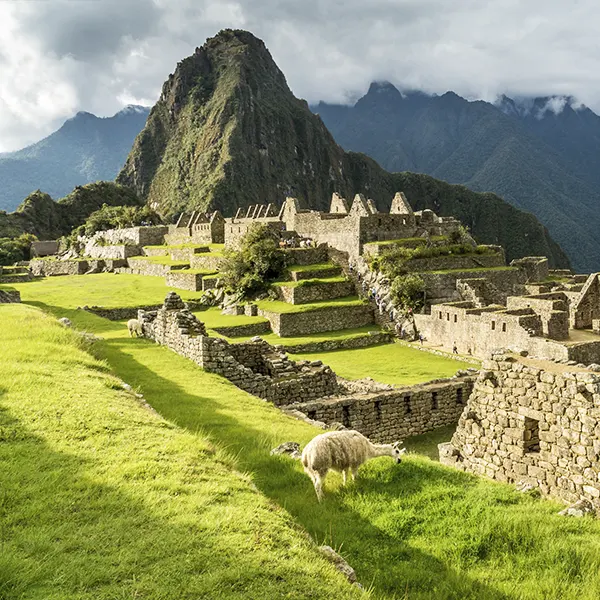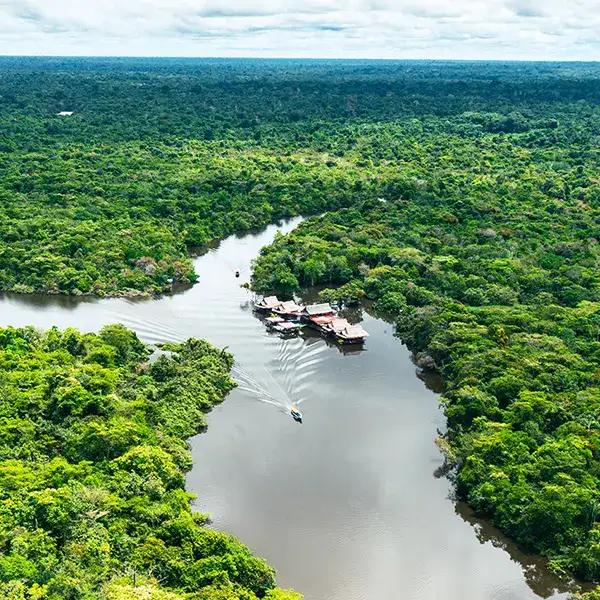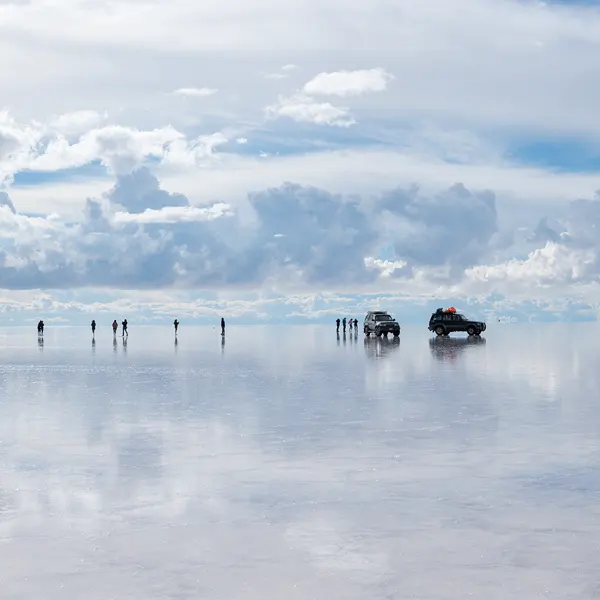Peru is not only Inca archaeological vestiges, the Amazon, paradise beaches, or adventure sports. Peru also has amazing traditional festivities, many of them very ancient, like the Lord of Earthquakes procession in Cusco. This sculpture of a crucified Christ, blackened by the smoke of the candles left for a long time in front of its altar in the Cathedral of the Imperial City, goes out in procession every first Monday of Holy Week in Cusco. It gathers more than 80 thousand pilgrims from Cusco, in a procession that is considered one of the largest in Peru and South America. Therefore, Machu Travel Peru brings you the most complete information about this traditional festivity of Patron juried of Cusco, which dates back to 1650!
Know more about the miraculous Lord of the Earthquakes, Saint Patron of Cusco
- The Lord of Earthquakes
- Location
- History
- Catholic Andean syncretism
- The procession
- How to participate
The Lord of Earthquakes
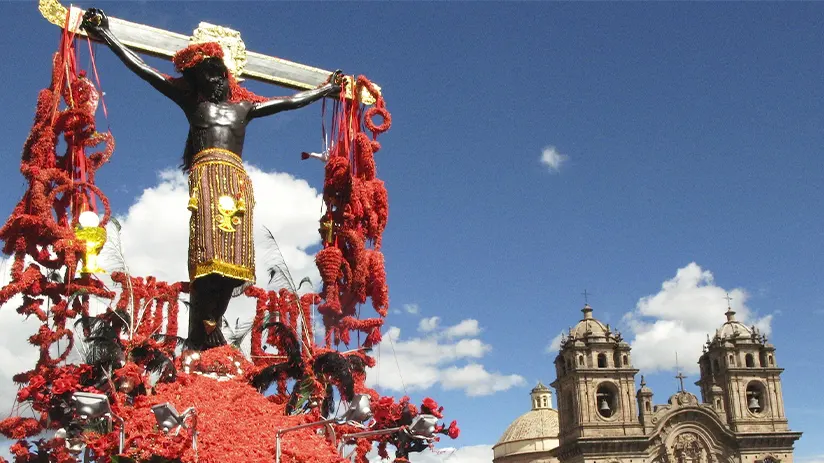
This effigy of glued fabric, polychrome wood, grotesque features, and asymmetrical anatomy represents a crucified Christ. The sculpture is hollow inside. Linen plant fiber makes up his head and body, both covered by small plates of maguey wood and plaster. His hands and feet are made of balsa wood to offer rigidity in union with the cross wood. Without mentioning that his hair and beard are of human origin!
The uniqueness of this sculpture is its black color. The smoke from the candles left by parishioners in front of its altar in the Cathedral of Cusco for centuries impregnated it with that characteristic dark color.
Location
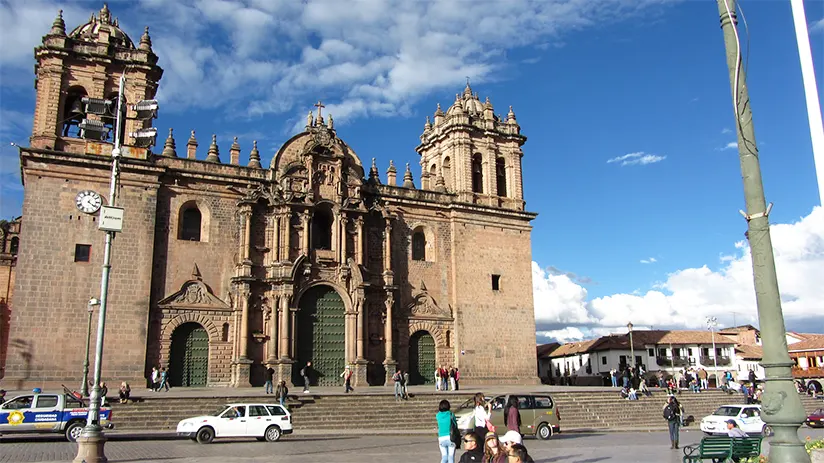
The Cusco Cathedral is divided into 3 naves. From west to east: The Gospel nave, the central nave, and the Epistle nave. Each nave hosts several chapels dedicated to different saints and virgins. Precisely, the Lord of Earthquakes is located in the third chapel of the Epistle nave. There, the sculpture of virgin Maria “La Dolorosa” (The hurt Virgin) and Saint John’s disciple accompany the effigy on each side.
History
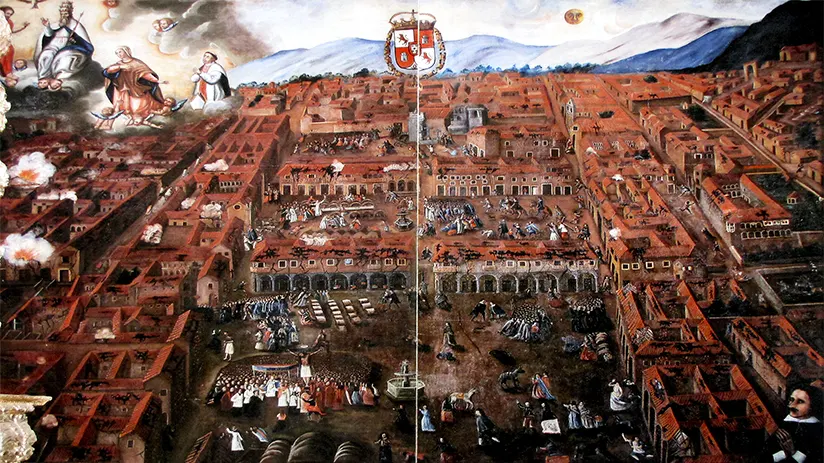
Its origins are as diffuse as they are surprising. The story says that the royal architect of the Spanish crown informed King Carlos I (Reigned from 1516 to 1556) that the process of evangelization in the Spanish colonies in America was going at a slow pace due to the stubbornness and obstinacy of the native Americans. Especially in a very important place for the Spanish, Cusco, the capital of the extinct Inca empire, in Peru.
Others affirm that the royal architect was one responsible for El Escorial construction and the king was Felipe II (Reigned from 1556 to 1598)
In any case, the Spanish king ordered the creation of an effigy of the crucified Christ to a famous artisan of Sevilla. His intention was clear, to strengthen the Catholic faith of the Cusco residents by giving them this effigy. However, this would have to be very different from the religious sculptures that abounded in Spain. This new sculpture would have to have grotesque features and a copper color for the American inhabitant to identify with it.
1. Heading America
There is no information about the exact date on the sculpture left from Spain to the Peruvian coast by ship. What we do know is that the ship experienced storms and bad weather and the sculpture had to be removed and held very close to the bow to calm the waters. Miraculously, the waters calmed down and they were able to continue their navigation to the port of Callao, in Peru.
From this point, the sacred sculpture was carried, through a muleteer, to Cusco. In those times, the trip can last weeks, even months.
2. The sculpture doesn’t want to move
Very close to Cusco, in the Mollepata town, the muleteer decided to take a rest for one night. The following morning, surprisingly, the chest where the sculpture was placed became heavy and could not be moved. Making it impossible to transport it to Cusco. After several attempts, the Mollepata population said that this fact was a divine decision, and they demanded that the sculpture stay in the town. In this form, the mule driver accepted the popular demand with the condition of constructing a Church in honor of the sculpture. Over the years, the population of Mollepata baptized this image, which until then had no name, as Señor Manuel de Exaltación de Mollepata.
The muleteer could not visit Cusco with empty hands. So he ordered an anonymous sculptor from Cusco to make another similar image. In this sense, he arrived with this new sculpture to Cusco. The priests of the Cusco Cathedral accepted the gift from the Spanish monarch and placed this new sculpture in a corner of the church, where another image called El Señor de la Buena Muerte “The Lord of the Good Death” previously stood.
3. The earthquakes
A great earthquake occurred in the city of Cusco at 2:00 p.m. on March 31, 1650. Houses, public palaces, and churches perished during this great earthquake of 7.6 degrees. After moving several religious effigies from inside to the main door of the Cathedral, to calm the violence of nature. And, seeing that nothing was working, the priests decided to try with a last effigy, the one that was a gift from the king of Spain and that had remained forgotten, only illuminated by the candles of some parishioners, in a corner of the Cathedral for years.
Again, miraculously and instantly, the telluric movements passed. In this form, the entire Cusco parishioner was amazed by the event in the Cusco main square. And, took out in a procession the sculpture, now nicknamed Lord of the Earthquakes. But, this is not only the unique occasion in which the effigy calmed a telluric movement. There were more over time. We can mention the earthquakes of 1707, 1950, and 1985. This last was the most recent catastrophic earthquake in Cusco. And even a plague in 1720, in which the Lord of the Earthquakes calmed the cruelties of nature miraculously and the Cusco population decided to name him Patron juried of Cusco (By replacing Santiago Saint who was the patron of the city from 1646)
Catholic Andean syncretism
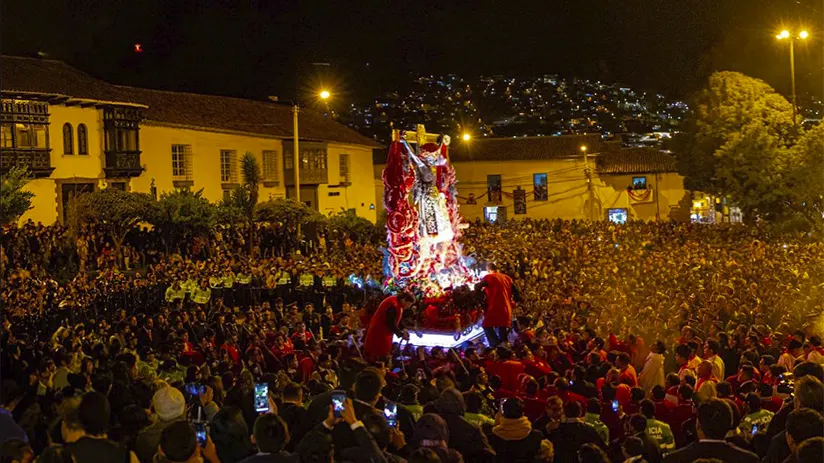
The Spanish imposed the catholic religion through religious images and sculptures on the recently conquered Incas as a form of evangelization. The Andean people adopted these new Catholic effigies to worship. But, in the process, they mixed them with their Andean pagan images which they could never forget. We can mention examples like paintings of virgins in the shape of mountains, and the placement of sacred stones (Huacas) under the litter of each Catholic sculpture taken in procession in modern times, among others.
In this sense, over time, the procession of the Lord of Earthquakes is the religious commemoration par excellence, where the local tradition reveals the Catholic-Andean syncretism. The Cusco pilgrims call to the Lord of Earthquakes “Taytacha” which means in the Quechua Language “Father”. Of course, the Taytacha is carried out in procession as the ancient Incas carried out their mummies (mummified corpses of their sovereigns) in procession. This is another clear example of syncretism Catholic-Andean.
A. Hidden letters
Between January and March 2005, during restoration works to the effigy in the Marquez de Valle Umbroso estate, the Cultural Institute National specialists found 61 letters of Cusco parishioners from different epochs inside the hollow thorax of the sculpture. The oldest letter dates from 1762!
But, How did letters come there? Well, these 61 passioned parishioners introduced their letters through the wound on the right side of the sculpture’s chest (Where the Roman soldier inserted his spear to confirm the death of Jesus in Catholic iconography). The letters express requests, supplications, and thanks to Taytacha for the miracles performed. This fact only demonstrates the extreme devotion and need of the Cusqueña parishioner to always be close to the Lord of Earthquakes.
The procession
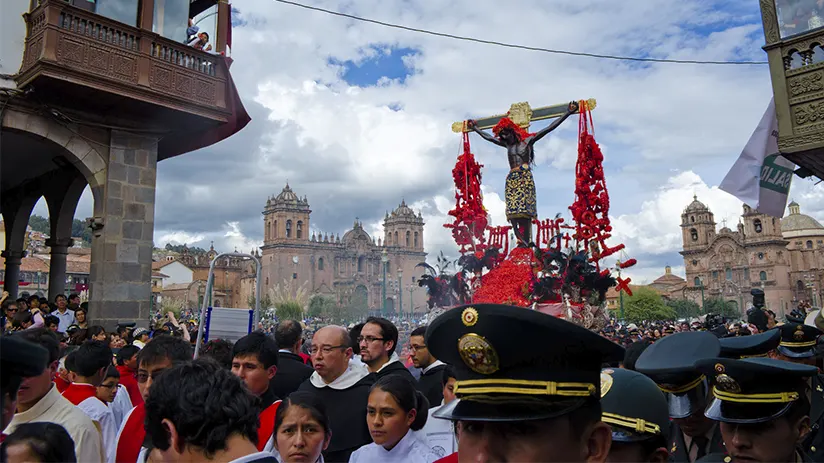
The procession of Lord of Earthquakes is developed every March 31 or on the date on which Holy Monday falls. And it is one of the most important festivals in Cusco! This day, the Cathedral is adorned with seasonal flowers (Ñucchu) and songs of two choirs of local old women from 05 am. These choirs, also called Chayñas, sing songs in the Quechua language with religious themes (syncretism) and are located on both sides of the main altar of the Cathedral, where is located the Lord of the Earthquakes. The Chayñas is a large tradition that is a heritage from Cusco mothers to daughters.
By the way, the referred sculpture was moved from its chapel located in the third zone of the Epistle nave to the main altar, 3 days before Holy Monday. The congregation of the Lord of Earthquakes was in charge of doing it, in addition to combing the hair, cleaning the body of the sculpture, place necklaces made of Ñucchu on the arms of the cross. Besides polishing his crown and cloves made of gold.
A. Masses and Ñucchu
This Holy Monday, the Cathedral of Cusco celebrates masses from 05 am up to noon, always accompanied by the Chayñas.
The procession begins at 2 pm and runs over the main streets of the Cusco Historic Center. A crowd of Cusco parishioners accompany the sacred statue by throwing it Ñucchu leaves. The Ñucchu (Salvia splendens) grows in the Andean lands during the rainy season (From November to March). This Andean red flower has beautiful red petals and it symbolizes Christ’s blood and passion. Usually, the local families, who will accompany the procession, collect this flower from higher parts of the city, days before. Therefore, many Cusco neighbors bathe the effigy with Ñucchu from their balconies. Music is not lacking, since the music band of the national police of Peru accompanies the procession.
B. Route of the procession
- Main door’s Cathedral. Main Square (First blessing). It begins at 2 pm.
- Plateros street.
- Santa Teresa church street (First rest). Here, the nuns of the Monastery of the Discalced Carmelites change the sculpture cloth with one specially made by them.
- Siete Cuartones street.
- Teatro Street.
- Educandas Street.
- San Francisco Square (Second blessing)
- Marquez Street.
- Espinar Plaza.
- La Merced Church (Second rest). Here, the effigy meets another one called (Virgen de la Soledad). The acolytes of the Mercedarian order change the sculpture cloth with one specially made by them.
- Mantas Street.
- Main door’s Cathedral. Main Square (Third blessing)
C. The last blessing
The Lord of Earthquakes gives its third, longest, and last blessing on the main door of the Cathedral, around 07 pm. During this moment, the sirens of the fire and police cars, that have accompanied the procession, sound. But, without doubt, the strong ringing of the great bell of the Cathedral, called Maria Angola, 2.10 high and almost 6 tons in weight, indicates the main blessing of the Lord of the Earthquakes. For some minutes, the Cusco parishioners remain silent and bow their heads receiving this blessing. In a true act of passion and regret.
Finally, the sculpture is carried inside the Cusco Cathedral, which is built on an ancient Inca temple that honors the pagan god Apulla Tikse Wiracocha (mixing Catholicism again with the Inca tradition, Syncretism)
How to participate
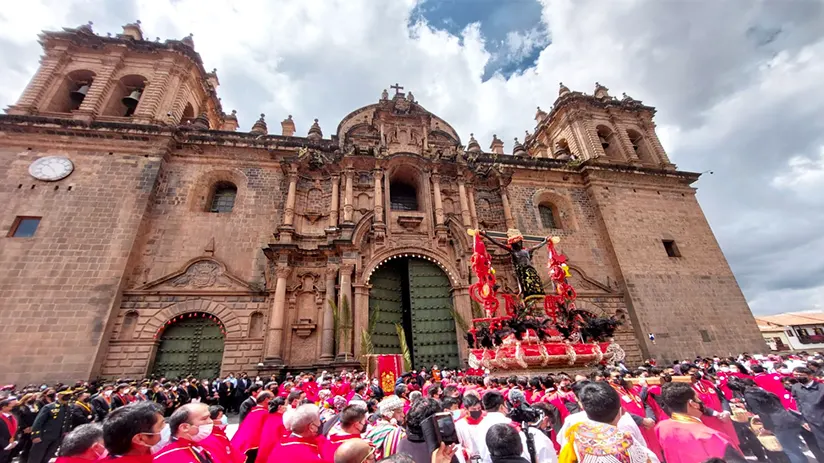
Participating in this religious activity is a unique experience in life. And the tips to know before you visit Cusco and this Catholic festivity are very easy. You just have to be present at 2:00 p.m. in the Cusco main square, waiting for the sacred sphinx to leave the Cathedral. Then you can accompany the procession along its entire route until the final blessing. You just have to be careful with your things, try to only carry a cell phone with a good camera and always have it on hand. Leave your wallet and valuables at your hotel and that’s it!
“IT TAKES AN ENDLESS AMOUNT OF HISTORY TO MAKE EVEN A LITTLE TRADITION”
We hope to bring you the fascinating history of one of the most important traditions of Cusco like the procession of the Lord of Earthquakes. In Machu Travel Peru, we are proud of this festivity that shows the best of the Cusquenean people, its union, and its confraternity. If you want more references to traditional festivities in the ancient capital of the Incas, we are here to assist you!
Peru has so much to offer, it can be hard to know where to start. With many years of experience in the tourism sector, Machu Travel Peru is happy to help with anything regarding your trip to Machu Picchu and any tours around it. Make your Machu Picchu experience an unforgettable one!

